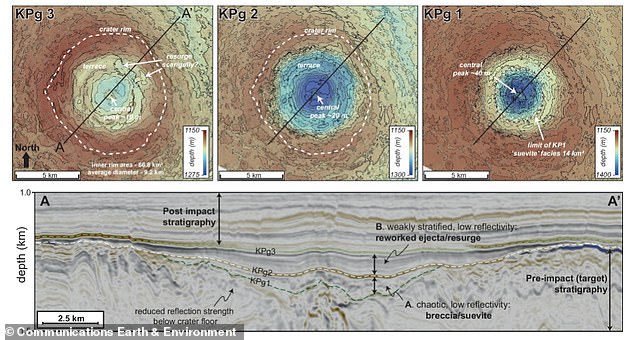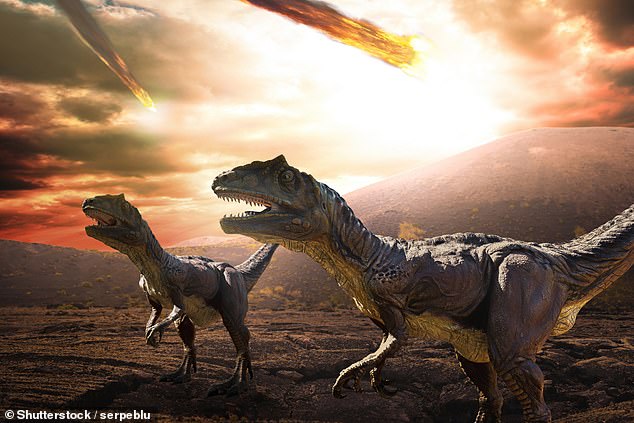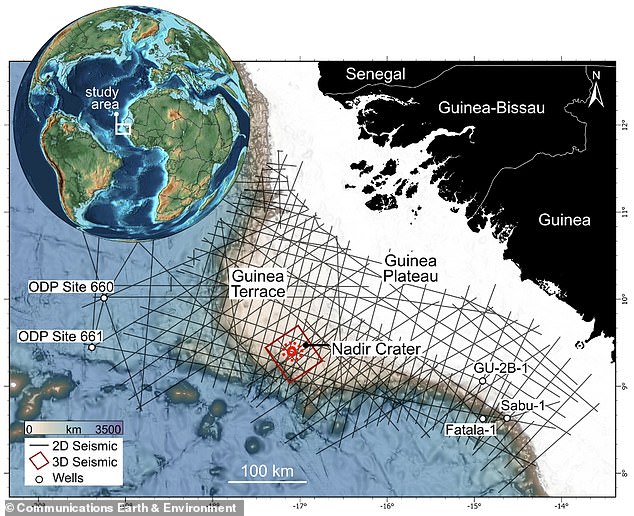The asteroid that killed the dinosaurs was NOT the only one: Scientists discover evidence that a second devastating space rock hit Earth 66 million years ago
It is known that the reign of the dinosaurs came to an end when a giant asteroid hit Earth 66 million years ago.
But a new study suggests this massive asteroid wasn’t alone.
Scientists from Heriot Watt University have discovered evidence that a second devastating space rock hit Earth in the same year.
This second asteroid was about 500 meters wide and struck Earth just off the coast of the Republic of Guinea in West Africa.
“The closest we have come to seeing something like this is the 1908 Tunguska event, when a 50 meter long asteroid entered the Earth’s atmosphere and exploded in the skies over Siberia,” said Dr Uisdean Nicholson, who led the research.
It is known that the reign of the dinosaurs came to an end when a giant asteroid hit Earth 66 million years ago. But a new study suggests this massive asteroid wasn’t the only one (stock image)
The first evidence of this second asteroid was discovered in 2022, while Dr. Nicholson and his team were studying seismic reflection data from the Atlantic Ocean seafloor.
The data revealed a depression nearly nine kilometers deep, which the team suspected could be an asteroid impact crater.
Now the researchers have captured new high-resolution 3D seismic images of the depression, which have confirmed their suspicions.
Called the Nadir Crater, the crater was carved out when an asteroid hit Earth about 66 million years ago – the same age as the dinosaur-killing asteroid.
‘There are about 20 confirmed marine craters worldwide, and none have been recorded in any detail. It is excellent,” said Dr. Nicholson.

Now the researchers have captured new high-resolution 3D seismic images of the depression, which have confirmed their suspicions

Scientists from Heriot Watt University have discovered evidence that a second devastating space rock hit Earth in the same year as the one that wiped out the dinosaurs.
‘Craters on the surface are usually heavily eroded and we can only see what is visible, while craters on other planetary bodies usually show only the surface expression.
“These data allow us to fully image this in three dimensions and peel back the layers of sedimentary rock to view the crater at all levels.”
In 2022, the researchers suggested that the asteroid would have been about 400 meters wide.
However, the new images confirm that it was even bigger.
Dr. Nicholson said: ‘We now think the crater was 450 to 500 meters wide, due to the larger crater size, as shown in the 3D data.
‘We can see that it came from about 20 to 40 degrees to the northeast, due to spiral, thrust-generated ridges around the central summit of the crater – which are only formed after a low-angle oblique impact.
‘And we think the Earth would have been hit at a speed of about 20 km per second or 72,000 km per hour, although we still need to confirm this with a new set of impact models.’

This second asteroid was about 500 meters wide and struck Earth just off the coast of the Republic of Guinea in West Africa (Nadir Crater, photo)
Based on the data, the scientists have created a timeline of what they think happened: from the initial collision to a tsunami more than 800 meters high that would have traveled across the Atlantic Ocean.
‘After the impact and the central uplift, the soft sediments surrounding the crater flowed inwards towards the evacuated crater floor, creating a visible ‘rim’,’ explained Dr. Nicholson out.
‘The earthquake caused by the impact appears to have liquefied sub-seafloor sediments across the entire plateau, causing fractures to form beneath the seafloor.
‘The impact was also accompanied by large landslides as the edge of the plateau collapsed beneath the ocean.
‘In addition, we see evidence for a series of tsunami waves moving away from and then back towards the crater, with large scars preserving evidence of this catastrophic event.’
Although it has been 116 years since an asteroid like this has been seen, it likely won’t be long before another massive space rock hits our planet, according to NASA.
The US space agency predicts that asteroid Bennu has a one in 2,700 chance of colliding with Earth on September 24, 2182.
